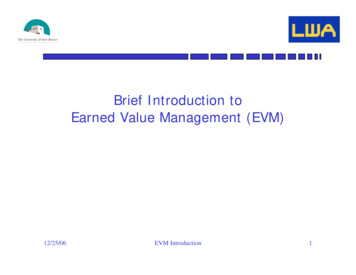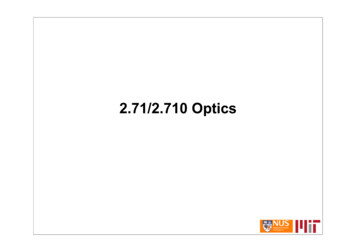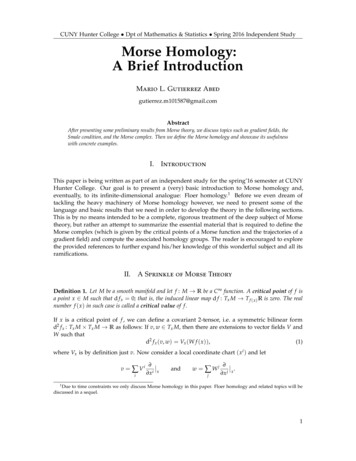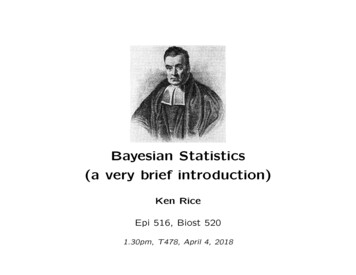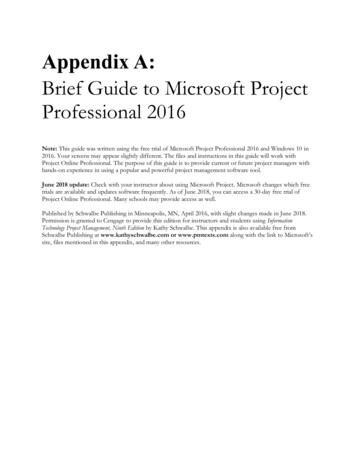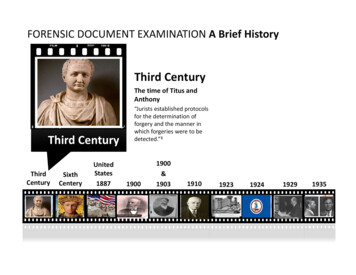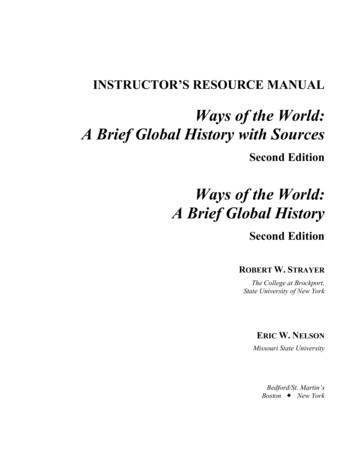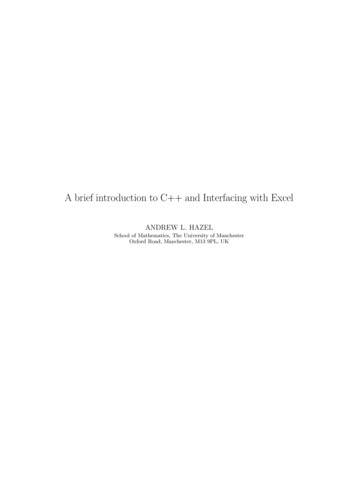
Transcription
A brief introduction to C and Interfacing with ExcelANDREW L. HAZELSchool of Mathematics, The University of ManchesterOxford Road, Manchester, M13 9PL, UK
1CONTENTSContents1 Introduction31.1 The programming work cycle . . . . . . . . . . . . . . . . . . . . . . . . .41.2 The simplest C program . . . . . . . . . . . . . . . . . . . . . . . . . .41.3 The C keywords . . . . . . . . . . . . . . . . . . . . . . . . . . . . . .51.4 Syntax of the source code . . . . . . . . . . . . . . . . . . . . . . . . . . .51.5 Practicalities: compiling and running C . . . . . . . . . . . . . . . . .61.5.1Simple command-line compilation . . . . . . . . . . . . . . . . . .71.5.2Visual Studio Compilation . . . . . . . . . . . . . . . . . . . . . . .82 Getting started with C 122.1 Data types . . . . . . . . . . . . . . . . . . . . . . . . . . . . . . . . . . .122.2 Variables . . . . . . . . . . . . . . . . . . . . . . . . . . . . . . . . . . . .122.2.1The scope of variables . . . . . . . . . . . . . . . . . . . . . . . . .132.2.2Arrays . . . . . . . . . . . . . . . . . . . . . . . . . . . . . . . . . .132.2.3Dynamic memory allocation and pointers . . . . . . . . . . . . . .142.3 Manipulating Data — Operators . . . . . . . . . . . . . . . . . . . . . . .172.3.1Arithmetic Operators . . . . . . . . . . . . . . . . . . . . . . . . .172.3.2Relational and logical operators . . . . . . . . . . . . . . . . . . . .182.3.3Shorthand operators . . . . . . . . . . . . . . . . . . . . . . . . . .192.4 Talking to the world — Input and Output . . . . . . . . . . . . . . . . . .192.4.1A note on namespaces . . . . . . . . . . . . . . . . . . . . . . . . .212.4.2File I/O . . . . . . . . . . . . . . . . . . . . . . . . . . . . . . . . .212.5 Conditional evaluation of code . . . . . . . . . . . . . . . . . . . . . . . .222.5.1if . . . . . . . . . . . . . . . . . . . . . . . . . . . . . . . . . . . . .232.5.2The ? command . . . . . . . . . . . . . . . . . . . . . . . . . . . .242.5.3switch . . . . . . . . . . . . . . . . . . . . . . . . . . . . . . . . . .252.6 Iterative execution of commands — Loops . . . . . . . . . . . . . . . . . .262.6.1for loops . . . . . . . . . . . . . . . . . . . . . . . . . . . . . . . . .262.6.2while and do-while loops . . . . . . . . . . . . . . . . . . . . . . . .282.7 Jump commands . . . . . . . . . . . . . . . . . . . . . . . . . . . . . . . .293 Functions313.1 Where to define functions . . . . . . . . . . . . . . . . . . . . . . . . . . .323.2 Function libraries . . . . . . . . . . . . . . . . . . . . . . . . . . . . . . . .34
2CONTENTS3.3 Modifying the data in function arguments . . . . . . . . . . . . . . . . . .353.4 Function overloading . . . . . . . . . . . . . . . . . . . . . . . . . . . . . .364 Objects and Classes384.1 Object-oriented programming . . . . . . . . . . . . . . . . . . . . . . . . .384.2 The C class . . . . . . . . . . . . . . . . . . . . . . . . . . . . . . . . .384.3 Constructors and Destructors . . . . . . . . . . . . . . . . . . . . . . . . .434.4 Inheritance . . . . . . . . . . . . . . . . . . . . . . . . . . . . . . . . . . .464.4.1Overloading member functions . . . . . . . . . . . . . . . . . . . .484.4.2Multiple inheritance . . . . . . . . . . . . . . . . . . . . . . . . . .514.5 Pointers to objects . . . . . . . . . . . . . . . . . . . . . . . . . . . . . . .514.6 The this pointer . . . . . . . . . . . . . . . . . . . . . . . . . . . . . . . .525 Interfacing C and Excel5.1 Writing a simple Excel Add-In in C . . . . . . . . . . . . . . . . . . .53535.1.1Creating the DLL in Visual Studio . . . . . . . . . . . . . . . . . .535.1.2Calling the library functions from within Excel . . . . . . . . . . .565.2 Using Excel from within C . . . . . . . . . . . . . . . . . . . . . . . . .585.3 The Excel Object Model . . . . . . . . . . . . . . . . . . . . . . . . . . . .605.3.1The Excel Application . . . . . . . . . . . . . . . . . . . . . . . . .615.3.2The Excel Workbook . . . . . . . . . . . . . . . . . . . . . . . . . .615.3.3The Excel Worksheet and Ranges . . . . . . . . . . . . . . . . . . .61
1 INTRODUCTION13IntroductionComputers are an essential tool in the modern workplace. They are ideally suited tothe processing, analysis and simulation of data. In order to use a computer to solve aparticular problem, however, we must generate a list of instructions for the computer tofollow, a task known as programming. For common tasks, the lists of instructions willalmost certainly have been created by somebody else and we can use their work to solveour problem. For example, Microsoft Excel contains the instructions to perform a hugenumber of standard tasks. Nonetheless, Excel cannot do everything; and for unusual, ornew, tasks a new set of instructions must be written. The aim of this course is to provideyou with the necessary skills to generate your own lists of instructions so that you canuse computers to perform (almost) any task.A programming language is a set of keywords and syntax rules that are used to “tell”the computer what you want it to do. A list of instructions written in a programminglanguage is called a program and is most often created using text editors or the texteditor component of an integrated development environment. Ultimately, these instructions must be translated from the programming language into the native language of thecomputer (assembly instructions). The translation is performed by specialised programsknown as compilers. In order to use a programming language you must have a compilerfor that language installed on your computer.At the time of writing, there are hundreds, if not thousands, of different programminglanguages, each with different strengths and weaknesses. The choice of programminglanguage is driven in part by the nature of the project. Excel Visual Basic for Applications(VBA) is the native language of Excel and is ideal for writing small extensions, or macros,within Excel Worksheets. In essence, Excel is the compiler for Excel VBA. VBA is notsuitable for every task, however. One restriction is that the language is not very portable;every Excel VBA program must run from within Excel, which means that you need tohave Excel installed on your computer. In addition, for intensive numerical calculations,VBA can be rather slow.1C is perhaps best described as middle-level, computer-programming language. Itis highly portable (there are compilers for almost all computers), efficient and very popular. In these notes, we shall discuss how to use C on its own and in conjunction withExcel, allowing the development of powerful and efficient solutions to complex problems.1 VBAis an interpreted language; its commands are translated into assembly language “line by line”and the translation takes up time during the execution of the program.
41 INTRODUCTION1.1The programming work cycleThe compiler is responsible for checking that what you have written is legal; i.e. thatyou have obeyed all the syntax rules and not violated any restrictions in the language.When programming, a large amount of time is spent correcting your program in responseto compiler errors.Once compiled, or built, the program must then be run, or executed, at which pointthe computer will carry out the tasks specified in the program. Just because a programcompiles, however, does not mean that it will run. It is perfectly possible to write asyntactically correct program that tries to perform an illegal action, for example dividingby zero. These run-time errors, as opposed to compile-time errors, are another source,or rather sink, of development time.The basic work cycle when writing computer programs is illustrated below:Write yCompileRunXXXXXX XXX I@X@ XXXX XCompile-Time DebuggingRun-Time DebuggingFor complex projects, the work cycle can be simplified by using an integrated development environment (IDE), such as Microsoft Visual Studio, or the Visual Basic Editorwithin Excel. The development environment contains a text editor, for writing programs;a compiler, for building the programs; and a whole range of debugging tools for trackingdown problems during the compilation and/or execution of the program. For the uninitiated, however, IDEs can seem overwhelming with a huge range of options that are notrequired for simple projects.1.2The simplest C programEvery valid C program must “tell” the compiler where its set of instructions startsand finishes. Hence, every C program must contain a function, see §3, that containsevery instruction to be performed by the program. The required function is calledmain() and the simplest C program is shown below:int main() {}The program is very boring because the function contains no instructions, but it willcompile and it will run. The keyword int indicates that the function main() will return
51 INTRODUCTIONan integer (a whole number) when it has completed all its instructions. In C , setsof instructions are grouped together by braces, sometimes called curly brackets, {};everything between the braces following main() will be executed while the program isrunning. The round brackets are used to specify arguments to functions, see §3. It ispossible to write programs using only the main function, but to do so would fail to takeadvantage of the more powerful structural features of C .1.3The C keywordsThere are 32 keywords defined by the ANSI C standard, see Table 1. If you are programming in C, these are the only keywords that you have to remember and, in practice,the working vocabulary is about 20 words. The C standard defines an additional 32keywords, shown in Table 2. C is a rapidly evolving language and the number ofkeywords may still change in the future. Case is important in C and keywords mustbe specified in lower case: e.g. else is a keyword, but Else, ELSE and ELSe are atiledoifstaticwhileTable 1: The 32 C keywords1.4Syntax of the source codeThe key elements of C syntax are shown below: A semicolon is used to mark end of an instruction. Case is important, i.e. sin is not the same as SIN. Totally free form, lines and names can be as long as you like! Comments take the form /* C style comment */ or // C style comment.
61 const castmutablereinterpret casttypenamedeletenamespacestatic castusingdynamic castnewtemplatevirtualexplicitoperatorthiswchar tTable 2: The 32 additional C keywords Groups of instructions are surrounded by braces {}.The most important point to remember is that all statements must end with a semicolon ;. Often, forgetting a semicolon can cause a huge number of compilation errors,particularly if the omission is near the start of a program.1.5Practicalities: compiling and running C Before it can be compiled, a C program must be saved as a file and, by convention, C programs are labelled by the filename extensions .cc, .cpp or .C. Largeprojects may, and probably should, be split into separate files, which can be compiledseparately. The division of large projects into separate “compilation units” speeds upthe re-compilation of the whole project if only one small part of the project has beenchanged. Keeping track of separate files and their interdependence is an area in whichIDEs are extremely useful. The alternative is to use command-line compilation and keeptrack of all the different files yourself.A command line is, as the name suggests, a place where you can issue (type) commands. Rather than clicking an icon to start a program, you must type the name of theprogram and then press return. Before windowing environments, all computation wasperformed using the command line and it is still easier, and quicker, to use the commandline for compiling very simple programs.We consider both “simple” command-line compilation and compilation within an IDE(Visual Studio) for a simple program that merely prints the word Hello on the screen.The C instruction that performs this task isstd::cout "Hello" std::endl;
1 INTRODUCTION7see §2.4.1.5.1Simple command-line compilationThe easiest way to write a small C program is to use a text editor, say Notepad,to generate a .cpp file that contains the required instructions and then to compile theprogram in a Command Prompt Window. The command for the Visual Studio C compiler is cl /EHsc file.cpp, where file.cpp is the file that contains your C program. The process is illustrated in Figure 1. The result of the compilation process isFigure 1: An illustration of simple command-line compilation. A Notepad windowcontaining a simple C program, hello.cpp, that will print the word Hello on thescreen; and a Visual Studio Command Prompt showing the compilation of the programhello.cpp and its execution.
1 INTRODUCTION8an executable file hello.exe. In order to run the program one can either double clickon the hello.exe program from the File Manager, or type hello.exe (and then return)into the command prompt, see Figure 1.This method of compilation will work for all simple projects, that is all projects inthis course. The method can be made to work for more complex projects, but it becomesmore and more difficult to do so.1.5.2Visual Studio CompilationA better way of managing large projects is to use Visual Studio. Initially, this willseem more complicated than the simple method outlined above, but it does not becomesignificantly more complex as the projects become larger. Once Visual Studio has beenstarted, it is used to write, compile and run the program. One major advantage of VisualStudio is that it automatically includes a number of libraries that are used to helpyour program interact with the Windows operating system. A library is a collection offunctions that have already been written and compiled. Precisely which libraries shouldbe included depends on the type of program that you are writing. If the program will usegraphics or interact with the mouse it requires more libraries than a simple commandline application. You can specify which libraries are included by choosing your projecttype when creating a new project. During this course, we shall consider only (Win 32)Console Applications and Win32 Projects.The first time that you run Visual Studio you may be asked to select a defaultenvironment, in which case you should select “Visual C Development Settings”. InVisual Studio 2003 (and earlier), the Start Page of Visual Studio contains a New Projectbutton, which when pressed brings up the New Project dialog box, see Figure 2. InVisual Studio 2005, the same dialog box is accessed by clicking the Project: Create linkin the Recent Projects window on the Start Page.For simple C programs, the project should be a Visual C Console Application,also called a Win32 Console Application, located in the Win32 submenu of the VisualC project templates. Filling in a name, e. g. Hello, for the project in the dialogbox and double-clicking on the Console Application icon from the Templates window (orclicking Open in the dialog box after selecting the Console Application icon) will bring upthe Application Wizard. For the default settings, simply press Finish and Visual Studiowill then create a number of files, which should appear in the Solution Explorer windowon the side of the screen. For information you can double-click on the ReadMe.txt file.Double-clicking on Hello.cpp (the actual C program) brings up a short section of
91 INTRODUCTIONFigure 2: Visual Studio Start Page and New Project dialog. A Console Applicationcalled Hello is about to be created.C code, see Figure 3. In order to write our own program, we comment out the precreated instruction in the function inttmain() and add our instruction. The programmay then be compiled by going to the Build menu and choosing the Compile option.Alternatively, we can choose to run our program by selecting Start from the Debugmenu. If the program has been modified without compiling it a dialog box pops up, seeFigure 4, pressing yes causes the program to be compiled and then run. Thus, the entirewrite, compile and run process takes place within Visual Studio.A complete description of the features of Visual Studio is well beyond the scope ofthis introductory course. A vast amount of information is provided in the on-line helpdocumentation.
1 INTRODUCTION10Figure 3: A Visual C Console Application, Hello, and the main source codeHello.cpp. The Run command is about to be issued.
1 INTRODUCTION11Figure 4: Visual Studio dialog box that appears when trying to run a program withoutre-compilation, clicking on Yes will cause the program to be compiled and then executed.
2 GETTING STARTED WITH C 212Getting started with C 2.1Data typesAlmost all computational tasks require the manipulation of data, e.g. finding the maximum of a set of numbers, printing an e-mail, modelling the growth of the stock market,etc. In C , the particular type of each datum must be declared before it can be used.It is possible to create your own “custom” data types, but for simple tasks the sevenbuilt-in data types (char, wchar t, bool, int, float, double and void) are sufficient.Table 3 shows the type of data represented by the first six keywords.chara single character (letter)wchar ta wide character (letter)(used for characters from non-english alphabets)boola boolean datum (true or false)intan integer datum (whole number)floata floating-point datumdoublea double-precision, floating-point datum(a real number with six digits of precision)(a real number with ten digits of precision)Table 3: The (non-void) C built-in data types.The void data type is rather special and is used to declare a function that does notreturn a value (a subroutine), see §3.2.2VariablesA variable is a named location in memory, used to store something that may be modifiedby the program. All variables must be declared before they are used. You can callvariables anything you like, provided that the name you choose does not start with anumber, is not a C keyword and is not the same as any other variable within thesame scope, see §2.2.1. It is usually a good idea to use descriptive names that indicatewhat the variable represents. Example declarations are shown below:int i,j,k;double a,b;char initial;
132 GETTING STARTED WITH C Note that commas may be used to separate variables of the same type and that each lineends with a semicolon. The initial value of a variable may be assigned when the variableis declared. Uninitialised variables can be a source of mysterious errors, so it’s a goodidea to initialise your variables if practical:int i 0,j 1,k 2;double a 12.35648;char ch ’a’;Note that characters must be enclosed in single quotes ’.2.2.1The scope of variablesC permits the declaration of variables anywhere within your program, but a variablecan only be used between the braces {} within which it is declared. The region in whichthe variable can be used is known as its scope. An advantage of local scopes is that youcan use the same name for variables within different regions of the same function. Thefollowing two example codes illustrate these ideas.int main()int main(){{//Declare a in new scope//Declare a in current scope{int a 10;}int a 10;//Declare a in new scope (ok)//Re-declare a in scope (illegal){int a 15;}int a 15;//a used outside scope (illegal)//a used in scope (ok)a 20;a 20;}}Neither of the two codes will compile.The code on the left fails on the last lineof main with the error ’a’ : undeclared identifier because a has not been declared in scope. The code on the right fails on the fourth line of main with the error’a’ : redefinition; multiple initialization because the variable a cannot be declared twice in the same scope.2.2.2ArraysAn array is a just like an array in maths: a collection of variables of the same type, calledby the same name, but each with a different index. The standard way to define an arrayis to enclose the dimension in square brackets [] after the variable name.
2 GETTING STARTED WITH C 14int x[100]; // 100 integer arraydouble y[300]; // Array of 300 doublesArrays are initialised by using braces to define the array and commas to separate theindividual array entries:double x[3] {1.0, 2.5, 3.7};The individual entries of an array are accessed by adding a single number in squarebrackets after the variable name. The array double x[3] has the entries x[0] ( 1.0),x[1] ( 2.5) and x[2] ( 3.7). Important note: In C , array indices start from 0.Multidimensional arrays are declared and initialised in an obvious way:double matrix[10][10];int 3dtensor[3][3][3] {{1,2,3},{4,5,6},{7,8,9}};The maximum number of dimensions, if any, is determined by the compiler. Note thatarrays defined in this way are allocated in the stack, an area of memory designed to storevariables with short lifetimes. The size of the stack is set by the operating system. Anarea of memory that is designed to store longer-lived variables is known as the heap, butcan only be accessed via dynamic allocation.2.2.3Dynamic memory allocation and pointersIn many cases, the size of the array will not be known when writing the program. Forexample, if we are reading in data from a file then the total number of data will dependon the size of the file. In these situations there are two options: Static Allocation: Allocate a fixed, but large, amount of storage, double A[1000];(possibly limited by stack size). Dynamic Allocation: Determine the exact amount of storage required as part ofthe program.In C dynamic memory allocation is handled by pointers, which are declared usingthe * operator.double *A dynamic;
2 GETTING STARTED WITH C 15We have declared the variable A dynamic as a pointer to a double, or an address inmemory. Declaring a pointer does not actually allocate any storage for a double variable,it merely “points” to an area of memory that can be used to store double variables. 2The use of pointers for dynamic memory allocation may seem rather convoluted, butpointers have many other uses. In particular, they are an essential part of the interfacebetween C and Excel — the only way that we can know where Excel has stored aparticular variable is by its memory address, i.e. a pointer, see §5.Having declared a pointer, we can use it to allocate storage for as many double dataas required. The instructionA dynamic new double[100];allocates an array of 100 double variables and the pointer refers to the first of thesevariables. We use the standard array syntax to access the variables, A dynamic[0] isthe first entry in the array, etc. Of course, if we knew that we needed storage for 100data we could have defined the array statically.The following program assigns storage for a number of int variables read in from afile, for details on file I/O see §2.4.2.#include iostream #include fstream using namespace std;int main(){//Declare and null a pointer to integer dataint *A dynamic 0;cout "Reading in data from file" endl;ifstream in file("input.dat");//The number of data must be the first entry in the fileint num data 0;in file num data;2 Theintroduction of a pointer does introduce an additional memory overhead because we have tostore the pointer itself. A bad choice of data structure with multiple pointers can be very wasteful.
2 GETTING STARTED WITH C 16//Allocate storageA dynamic new int[num data];//Loop over the number of data and read from filefor(unsigned i 0;i num data;i ){in file A dynamic[i];}//Close the filein file.close();//Calculate the sum of all the datadouble sum 0.0;for(unsigned i 0;i num data;i ) {sum A dynamic[i];}//Print out the average valuecout "Average value " sum/num data endl;//Free the memory allocateddelete[] A dynamic; A dynamic 0;}If the file input.dat contains the single line10 1 2 3 4 5 6 7 8 9 10the output from the program isAverage value 5.5Once we have allocated memory for variables using the new keyword, then we are incharge of cleaning up when we have finished with it. The keyword delete is used todeallocate memory. If an array has been allocated, square brackets must be added afterthe delete command, e.g. delete[] array data.If memory has been deleted then it can be reused by any other programs running onthe computer. If it is accidentally used by your program again, without reallocation, theresult is a nasty run-time error known as a segmentation fault. These are particularly
2 GETTING STARTED WITH C 17hard to track down because if the memory has not yet been grabbed by another programthen everything will appear to be fine. For this reason, it is very good practice to “nullout” unused pointers. When a pointer is declared, initialise it to null, 0, and when theallocated memory has been deleted reset the value of the pointer to zero.2.3Manipulating Data — OperatorsWe can now create and initialise variables, but how do we modify the data? The answeris to use operators, which, as the name suggests, operate on the data. The built-inoperators in C may be broadly subdivided into four classes arithmetic, relational,logical and bitwise.You have already been introduced to the assignment operator, . The most generalform of assignment isvariable expression ;Note that C will convert between data types in assignments. The code shown belowwill compile without complaint.int i 1;char ch;double d;ch i; // Conversion from int to chard ch; // Conversion from char to doubleThe compiler will usually do the right thing, for example converting from doubleto integer should give the integer part of the result. That said, it is unsafe to rely onautomatic conversion, and doing so can give rise to funny errors. Be sure to check datatypes in expressions carefully.2.3.1Arithmetic OperatorsTable 4 lists the C arithmetic operators, which are pretty obvious apart from the lastthree, %, -- and . The modulus operator, %, gives the remainder of integer division,it cannot be used on floating point data types. The increment and decrement operatorsmay seem strange at first: adds 1 to its operand and -- subtracts 1. In other words,x x 1; is the same as x; and x x - 1; is the same as x--;. Increment and
182 GETTING STARTED WITH C -Subtraction t IncrementTable 4: The C arithmetic operatorsdecrement operators can precede or follow the operand and there is only a differencebetween the two when used in expressions.x 10;y x; // Increments x and then assigns y; i.e. x y 11x 10;y x ; // Assigns y and then increments x; i.e. x 11, y 10Arithmetic operators are applied in the following order:First -- (unary minus)* / %Last -Parentheses () may be used to alter the order of evaluation by forcing earlier evaluationof enclosed elements. i. e. 2 3*5 17, but (2 3)*5 25.2.3.2Relational and logical operatorsRelational and logical operators rely on concepts of false and true, which are representedby integers in C . False is zero and true is any value other than zero. Every expressioninvolving relational and logical operators returns 0 for false and 1 for true. Table 5 showsall the relational and logical operators used in C .Examples of relational operations and their values are10 5 // True (1)
2 GETTING STARTED WITH C 19Relational operators Greater than Less than Greater than or equal Less than or equal Equal! Not equalLogical operators&&AND OR!NOTTable 5: The C relational and logical operators19 5 // False (0)(10 5 ) && (10 20) // True (1)10 5 && !(10 9) 3 4 // True (1)These operators are usually used to control the flow of a program and will be furtherexplored in section 2.5.2.3.3Shorthand operatorsC uses a convenient (well some would, and do, say obscure) shorthand to replacestatements of the form x x 1,x 10; /* is the same as */ x x 10;x - b;/* is the same as */ x x - b;This shorthand works for all operators that require two operands and is often used inprofessional C programs, so it is well worth taking the time to become familiar withit. In fact, shorthand operators are slightly more efficient because they avoid the needto create temporary variables.2.4Talking to the world — Input and OutputNo matter how wonderful your program is in isolation, at some point it’ll need to interactwith the outside world. I/O or input and output is not part of the standard C
202 GETTING STARTED WITH C keywords. The appropriate functions are present in libraries that can be incorporated intoany C program. The necessary library is called iostream and is included using thecompiler directive #include iostream . In fact, Visual Studio automatically includesthe appropriate libraries for you when it creates the Console Application template.An example of simple I/O is shown below#include iostream int main(){int i; //Declare an integer variablestd::cout "This is output.\n"; //print a stringstd::cout "Enter a number: ";std::cin i;//read in a number// output the number and its squarestd::cout i " squared is " i*i "\n";}std::cout is a stream that corresponds to the screen and std::cin is a stream thatcorresponds to the keyboard. The and operators are output and input operatorsand are used to send output to the screen and take input from the keyboard. Severaloutput operators can be strung together in the same command. The special character’\n’ represents a newline. This program reads into a variable, i, that has been declaredto be an integer and what you type at the keyboard is automatically converted into aninteger. If the input data is not of the correct type very strange things can happen, seebelow.%./a.outThis is outputEnter a number 55 squared is 25% ./a.out
2 GETTING STARTED WITH C 21This is outputEnter a number 1.45
A programming language is a set of keywords and syntax rules that are used to \tell" the computer what you want it to do. A list of instructions written in a programming . Excel, allowing the developme

